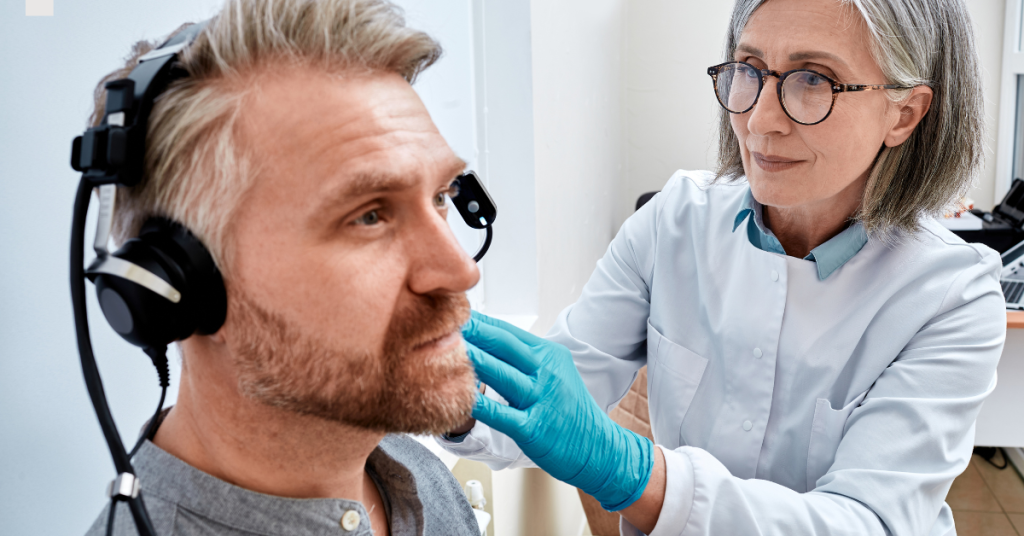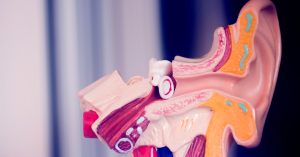Hearing loss can affect anyone, but it’s especially common among adults over 50. Whether it develops suddenly or gradually, the impact on daily life can be significant — making conversations difficult, increasing feelings of isolation, and even affecting mental health. One of the most common and urgent questions people ask when they notice changes in their hearing is: Is hearing loss reversible?
The answer isn’t always simple. Hearing loss can result from a variety of causes, and the possibility of reversal depends largely on the type and underlying condition. Some forms of hearing loss are temporary and fully treatable, while others may be permanent but manageable with medical intervention or hearing technology.
In this article, we’ll explore the different types of hearing loss, which forms may be reversible, and how to get the right support. Whether you’re experiencing hearing issues yourself or caring for someone who is, understanding the landscape of hearing health is the first step toward better outcomes. Let’s begin by breaking down the types of hearing loss and what they mean for potential reversibility.
Types of Hearing Loss and What They Mean for Reversibility
Understanding whether hearing loss is reversible starts with knowing what type of hearing loss you’re dealing with. Audiologists classify hearing loss into three main categories: conductive, sensorineural, and mixed. Each type has distinct causes and implications for treatment, with varying degrees of potential reversibility.
Conductive Hearing Loss
Conductive hearing loss occurs when sound is blocked from reaching the inner ear. This type is often caused by obstructions or malfunctions in the outer or middle ear — such as earwax buildup, fluid from an ear infection, a perforated eardrum, or abnormalities in the bones of the middle ear.
The good news is that conductive hearing loss is frequently reversible. Treatments may include removing blockages, treating infections with medication, or surgical procedures to repair physical issues. In many cases, once the underlying problem is resolved, hearing can return to normal or near-normal levels.
Sensorineural Hearing Loss
Sensorineural hearing loss is the most common type, particularly among older adults. It results from damage to the inner ear (cochlea) or the auditory nerve. Common causes include aging (presbycusis), prolonged exposure to loud noise, certain medications, head trauma, or illnesses that affect the auditory system.
Unfortunately, sensorineural hearing loss is typically permanent. The delicate hair cells inside the cochlea do not regenerate once damaged, and the auditory nerve cannot be “repaired” in the traditional sense. However, this type of hearing loss can often be effectively managed with hearing aids or cochlear implants, improving a person’s ability to hear and communicate.
Mixed Hearing Loss
As the name suggests, mixed hearing loss is a combination of conductive and sensorineural components. Someone may have both damage to the inner ear and an obstruction in the middle ear. Treatment for mixed hearing loss depends on which component is more dominant. The conductive portion may be treated to improve overall hearing, while the sensorineural component may require long-term management.
Reversible Causes of Hearing Loss
Not all hearing loss is permanent. In fact, several common causes of hearing loss are completely reversible with the right treatment. For many people, identifying and addressing these underlying issues early can mean a full return to normal hearing. Let’s take a closer look at the most frequent reversible causes and how they’re treated.
Earwax Buildup (Cerumen Impaction)
One of the simplest and most treatable causes of hearing loss is earwax buildup. When too much wax accumulates in the ear canal, it can block sound waves from reaching the eardrum, resulting in muffled hearing. This condition is especially common in older adults and those who use hearing aids.
Treatment:
Removal by a healthcare professional using suction, irrigation, or special instruments. Avoid using cotton swabs, which can push wax deeper and worsen the blockage.
Ear Infections and Fluid in the Middle Ear
Middle ear infections (otitis media) are typically caused by bacteria or viruses. They can lead to inflammation and fluid buildup behind the eardrum, which impairs sound transmission. While more common in children, adults can experience them too — especially after a cold or sinus infection.
Treatment:
Antibiotics (for bacterial infections), decongestants, or surgical drainage in chronic cases. Once the infection clears and fluid drains, hearing often returns to normal.
Swimmer’s Ear (Otitis Externa)
This is an infection or irritation of the outer ear canal, usually due to trapped water, bacteria, or fungi. Swimmer’s ear can cause swelling, discomfort, and temporary hearing loss as the ear canal narrows.
Treatment:
Prescription eardrops containing antibiotics, antifungals, or steroids. Keeping the ear dry during recovery is also essential.
Foreign Objects in the Ear Canal
It’s not just children who get things stuck in their ears — adults may accidentally insert hearing aid parts, broken earbuds, or cotton swab tips. These obstructions can lead to temporary conductive hearing loss until removed.
Treatment:
A medical professional can safely extract the object. Attempting removal at home may cause damage or push it deeper.
Ototoxic Medications
Some medications are known to be ototoxic, meaning they can damage the inner ear. However, not all drug-induced hearing loss is permanent. In cases where the medication is stopped early enough, hearing may recover fully or partially.
Treatment:
Immediate consultation with a doctor to assess medication risks. Alternative drugs may be prescribed, and hearing monitoring is crucial during treatment.
Barotrauma or Sudden Pressure Changes
Rapid altitude or pressure changes (e.g., during air travel or scuba diving) can temporarily affect hearing. This is typically due to pressure imbalances in the middle ear.
Treatment:
Yawning, swallowing, or using the Valsalva maneuver can equalize ear pressure. In more severe cases, medical intervention may be needed.
Irreversible Hearing Loss: Causes and Management Options
While some forms of hearing loss can be treated and reversed, others are permanent. These types of hearing loss typically result from damage to the inner ear or auditory nerve, where the body’s ability to repair itself is extremely limited. However, permanent doesn’t mean untreatable — with modern technology and support, people can still lead full and connected lives.
Age-Related Hearing Loss (Presbycusis)
Presbycusis is the most common cause of hearing loss in older adults. It develops gradually over time as the sensory cells in the cochlea deteriorate. This type of hearing loss usually affects both ears and is particularly noticeable when trying to hear high-pitched sounds or follow conversations in noisy environments.
Why It’s Irreversible:
The hair cells in the inner ear do not regenerate, and once they’re damaged, the resulting hearing loss is permanent.
Management Options:
- Hearing aids
- Assistive listening devices
- Communication strategies
Noise-Induced Hearing Loss
Exposure to loud noise — whether from a single loud blast or prolonged exposure to high decibel environments — can permanently damage inner ear hair cells. This type of hearing loss is entirely preventable, but once it occurs, it cannot be reversed.
Common Sources:
Loud music, power tools, firearms, machinery, and concerts.
Management Options:
- Hearing protection
- Hearing aids
- Cochlear implants
Genetic and Congenital Hearing Loss
Some individuals are born with hearing loss or develop it early in life due to genetic factors. This can be due to inherited conditions, syndromes, or prenatal factors such as maternal infections or birth complications.
Why It’s Irreversible:
In many cases, genetic mutations or structural abnormalities in the ear prevent normal hearing function.
Management Options:
- Early intervention
- Speech therapy and educational support
- Ongoing audiological care
Illness or Disease-Related Hearing Loss
Certain diseases — such as Ménière’s disease, autoimmune disorders, meningitis, or diabetes — can damage the auditory system over time or suddenly. Depending on the extent and location of the damage, hearing loss may be partial or total.
Why It Might Be Permanent:
Inner ear structures or auditory nerves can be irreversibly affected by inflammation, infection, or compromised blood flow.
Management Options:
- Medical treatment
- Audiological rehabilitation
- Support groups and counseling
Treatment Options: From Medical Interventions to Hearing Aids
Whether hearing loss is reversible or not, effective treatment options are available to help individuals hear better and stay connected to their world. The best approach depends on the type, cause, and severity of the hearing loss. This section outlines a range of treatments — from simple medical interventions to advanced hearing technologies.
Medical and Surgical Treatments
For conductive hearing loss, medical or surgical intervention often offers a complete solution. Common treatments include:
- Earwax removal
- Antibiotics or antifungal treatments
- Surgical repair
- Pressure equalization (PE) tubes
These interventions can restore hearing or prevent further decline when addressed early.
Hearing Aids
Hearing aids are the most common treatment for sensorineural hearing loss. These devices don’t restore natural hearing but amplify sounds to help users hear more clearly.
Types:
- Behind-the-ear (BTE)
- In-the-ear (ITE) and in-the-canal (ITC)
- Rechargeable and Bluetooth-enabled models
Cochlear Implants
For severe to profound hearing loss, cochlear implants may be recommended. These devices bypass damaged parts of the ear and stimulate the auditory nerve directly.
Who Can Benefit:
- Adults with late-onset hearing loss
- Children born with severe hearing loss
- Individuals not helped by hearing aids
Bone-Anchored Hearing Systems
Used for certain types of conductive or mixed hearing loss, these devices transmit sound through the skull to the inner ear, bypassing damaged areas.
Assistive Listening Devices (ALDs)
- Amplified phones
- TV listening systems
- Personal FM systems
- Alerting devices
Therapy and Counseling
Support services like auditory training, speech therapy, and counseling enhance communication skills and reduce the emotional impact of hearing loss.
When to See a Hearing Specialist
One of the most important steps in addressing hearing loss is recognizing when it’s time to seek professional help. Because hearing changes can occur gradually, many people delay treatment — often for years.
Signs You Should Get Your Hearing Checked
- Asking others to repeat themselves
- Trouble following conversations
- Increasing volume on devices
- Muffled or plugged ears
- Ringing in the ears (tinnitus)
- Avoiding social situations
Who to See
- Audiologists
- Otolaryngologists (ENTs)
- Hearing instrument specialists
What to Expect During a Hearing Evaluation
- Case history
- Physical examination
- Hearing tests and audiogram analysis
The Benefits of Early Detection
- Better treatment outcomes
- Preservation of communication skills
- Reduced risk of social withdrawal
- Improved quality of life
Conclusion
Hearing loss is a complex condition with a wide range of causes, degrees, and outcomes. The big question — is hearing loss reversible? — depends largely on what’s causing it. For some, hearing can be fully restored through simple treatments. For others, hearing loss may be permanent but still manageable.
With the right tools, early support, and consistent care, individuals can regain control of their hearing health and improve their overall well-being. Above all, the key is early action. Don’t wait — your hearing health is too important to ignore.
FAQ
What types of hearing loss are reversible?
Reversible hearing loss is usually caused by issues in the outer or middle ear, such as earwax buildup, ear infections, or fluid behind the eardrum.
Can sensorineural hearing loss ever be reversed?
Sensorineural hearing loss is generally permanent but can be managed with hearing aids or cochlear implants.
How do I know if my hearing loss is temporary or permanent?
Only a hearing specialist can determine the nature of your hearing loss through examination and testing.
Are hearing aids a cure for hearing loss?
Hearing aids don’t cure hearing loss but significantly improve hearing by amplifying sound.
When should I seek help for hearing problems?
If you notice persistent hearing changes or difficulties, you should see a hearing specialist promptly.
“This article is for informational purposes only and is not a substitute for professional medical advice, diagnosis, or treatment. If you are concerned about your hearing or ear health, please consult a qualified healthcare provider.”






